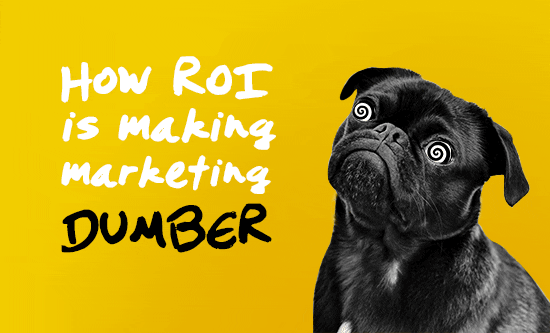Twenty years ago, marketing was broadly regarded as the ‘Colouring In Department’, noted for an ability to spend money with little or no accountability. I remember a well-respected CMO of a large Australian company joking with me that he could spend $3m on an advertising campaign and nobody would bat an eyelid, but if IT wanted to spend $1m on software or technology, it would take them 12 months to get it approved.
A backlash against marketing and a need to create accountability changed all that.
As marketers learned how to calculate ROI, marketing went from being an unaccountable expense to a closely tracked and monitored corporate activity. Marketers had to prove that the money they spent was going to deliver a return to the organisation through incremental sales and margins.
Money flowed from above the line to below the line, because below the line was more “accountable” and “measurable”. Money followed the perception of accountability…This was generally a very good thing for marketing and organisations. But it has had one very interesting and unintended consequence on the quality of marketing
The basic calculation of ROI is Return (sales or profit) / Investment (cost of executing the campaign). R/I was a simple way to calculate return and most organisations would expect R/I to be 2-3. So for every $1 spent on marketing, there is an expected return of $3 to $5.
Up until ten years ago, most “below the line” marketing was spent on direct mail campaigns and call centres. This meant there was a real cost to execution (sending direct mail and having people on phones cost real money). The cost of contacting a customer was between $2 and $10 a contact. To get a “Return” on this “Investment”, we had to think hard, make sure we targeted only the people who were most likely to respond. If we got the targeting wrong, and sent our direct mail out to too many people, we would destroy our ROI.
Today, most campaigns are digital and the cost of execution per customer is not measured in $ but rather in fractions of a fraction of a cent. In effect, the “I” component of the equation has descended to near enough zero. That means you don’t need a very high “R” to get a return on any campaign. What’s more, even if you don’t get any “R” at all, the “I” is so low that nobody cares and we can simply label it as a “Test and Learn” campaign.
This has, however, had an interesting but rather unfortunate effect on the quality of marketing. Suddenly, the cost of execution is lower than the cost of thought. Now it’s cheaper to execute a campaign to *.* (everyone) than it is to spend time doing analysis and identifying the right targets. The result? ROI is making marketing dumber. If all we do is focus on ROI, then the logical outcome is a constant stream of untargeted spam. And it gets worse. Using an ROI model, when “R” starts to fall (because people opt out and ignore your emails), the logical solution is to increase volume since the “I” is so small. Small increases in “R” justify and even encourage larger increases in volume…high volumes of poorly targeted, poorly conceived marketing.
What is needed is a counter measure to ROI as a way of balancing out the measure of success – a measure that considers the impact of our customer interactions and focuses on building engagement with customers through relevance. We need to be able to measure the negative impact of over communication with irrelevant communication and to quantify the future value of a more engaged customer. That is the smart Return we should be seeking on our marketing Investment.
 by Regan Yan, CEO of Digital Alchemy.
by Regan Yan, CEO of Digital Alchemy.
Regan is a subject-matter expert in analytical database marketing and customer relationship marketing, as well as an in-demand keynote speaker at national and international events. He also authors thought leadership pieces on data-driven marketing that can be found on our DA Blog.



